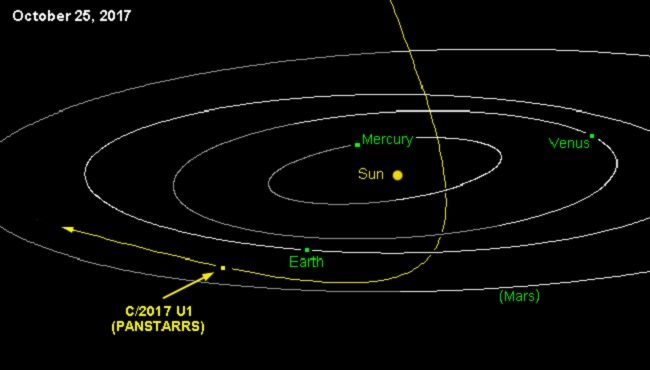
But an object swept up just a week ago by observers using the PanSTARRS 1 telescope atop Haleakala on Maui has an extreme orbit - it's on a hyperbolic trajectory that doesn't appear to be bound to the Sun. Preliminary findings, published earlier today by the International Astronomical Union's Minor Planet Center (MPC), suggest that we are witnessing a comet that escaped from another star.
"If further observations confirm the unusual nature of this orbit," notes Gareth Williams, the MPC's associate director, "this object may be the first clear case of an interstellar comet."
Designated C/2017 U1, Comet PanSTARRS was a dim, 20th-magnitude blip when first spotted on October 18th, after having zipped within 37,600,000 km (23,400,000 miles) of the Sun on September 9th. Such a close approach to the Sun's searing heat would ordinarily spell doom for a small comet. Based on its apparent brightness, dynamicist Bill Gray calculates that it would have a diameter of about 160 meters (525 feet) if it were a rock with a surface reflectivity of 10%. "It went past the Sun really fast," Gray notes, "and may not have had time to heat up enough to break apart."
Now it's headed out of the solar system, never to return. It passed closest to Earth on October 14th at a distance of about 24,000,000 km (15,000,000 miles), and astronomers worldwide have been tracking it in the hopes of divining its true nature - especially whether it's displaying any cometary activity.
What gives C/2017 U1 away as an interstellar visitor wasn't its very high inclination (122°) with respect to Earth's orbit, which isn't particularly rare, but more critically its extreme hyperbolic eccentricity (1.19). Check out the comet's pass through the inner solar system using JPL's interactive Horizons app (requires Java).

According to Gray, Comet PanSTARRS appears to have entered the solar system from the direction of the constellation Lyra, within a couple of degrees of right ascension 18h 50m, declination +35° 13′. That's tantalizingly close to Vega - and eerily reminiscent of the plot of the movie Contact - but its exact path doesn't (yet) appear to link any particular star.
This object entered the solar system moving at 26 km (16 miles) per second. At that speed, in 10 million years it would traverse 8,200,000,000,000,000 km - more than 850 light-years.



Now that comets have been proved not to be "dirty snowballs," there is no longer any reason to believe in the existence of the Oort cloud.